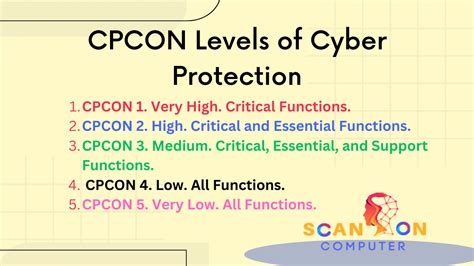Sherly
You need 3 min read
Post on Feb 03, 2025
Table of Contents

Cyberspace Protection Condition (CPCON) Levels: Understanding and Responding to Cyber Threats
The digital landscape is constantly evolving, with cyber threats becoming increasingly sophisticated and frequent. To effectively manage these risks, the U.S. government and other organizations utilize the Cyberspace Protection Condition (CPCON) system. This system provides a standardized framework for assessing and responding to cyber threats, allowing for proactive mitigation and incident response. Understanding the different CPCON levels is crucial for organizations and individuals alike to maintain cybersecurity posture.
What is CPCON?
CPCON is a graduated scale that reflects the current level of cyber threat to a specific organization or network. It's a crucial tool for prioritizing resources and implementing appropriate security measures. The system operates on a five-level scale, ranging from Normal (CPCON 1) to Severe (CPCON 5). Each level corresponds to a specific threat assessment and dictates the necessary actions to protect sensitive data and infrastructure.
The Five CPCON Levels:
-
CPCON 1 - Normal: This is the baseline level, indicating a low threat environment. Organizations maintain their standard security posture, conducting regular vulnerability assessments and updates. Security awareness training remains a key focus.
-
CPCON 2 - Elevated: A moderate threat is present. Organizations should increase vigilance, enhance monitoring activities, and review their security plans. Vulnerability assessments become more frequent, and incident response procedures are reviewed.
-
CPCON 3 - Increased: A significant threat is detected, demanding a heightened security posture. Organizations may implement additional security measures, such as strengthening access controls and increasing network monitoring. Security awareness training may be intensified.
-
CPCON 4 - High: A severe threat is imminent or has occurred, requiring immediate and decisive action. Organizations will likely implement significant security enhancements, potentially limiting access to systems and implementing stricter access controls. Incident response teams are activated and actively manage the situation.
-
CPCON 5 - Severe: This is the highest level, indicating a catastrophic cyber threat with widespread impact. Organizations will take extreme measures to contain the threat, potentially including system shutdowns and significant operational changes. Close coordination with relevant authorities is critical.
How CPCON Affects Organizations
The CPCON level significantly influences an organization's cybersecurity strategy. Understanding the implications of each level allows for appropriate resource allocation and response planning. For example:
-
Increased Monitoring: Higher CPCON levels necessitate increased monitoring of networks and systems for suspicious activity.
-
Enhanced Access Controls: Stricter access controls and authentication measures are implemented to restrict unauthorized access.
-
Incident Response Planning: Regular review and testing of incident response plans are essential to ensure readiness for potential attacks.
-
Vulnerability Management: Proactive vulnerability management is paramount, with regular patching and updates to address known vulnerabilities.
-
Security Awareness Training: Educating employees about cybersecurity threats and best practices is crucial at all CPCON levels.
Staying Informed About CPCON Levels
While specific CPCON levels are often communicated internally within organizations or government entities, understanding the general principles and potential implications of each level is crucial for anyone involved in cybersecurity. Staying informed about emerging threats and best practices is a continuous process that requires proactive engagement with cybersecurity news and resources. By understanding the CPCON system, organizations and individuals can better protect themselves from the ever-evolving landscape of cyber threats.
Conclusion
The Cyberspace Protection Condition (CPCON) system provides a valuable framework for managing and responding to cyber threats. By understanding the different levels and their implications, organizations and individuals can effectively prioritize resources and implement appropriate security measures to protect against attacks. Maintaining a proactive and informed approach to cybersecurity is essential in today's digital world. Regularly reviewing and updating security plans, implementing robust security controls, and keeping abreast of the latest threats are vital for minimizing risks and ensuring resilience in the face of cyberattacks.
Thanks for visiting this site! We hope you enjoyed this article.
